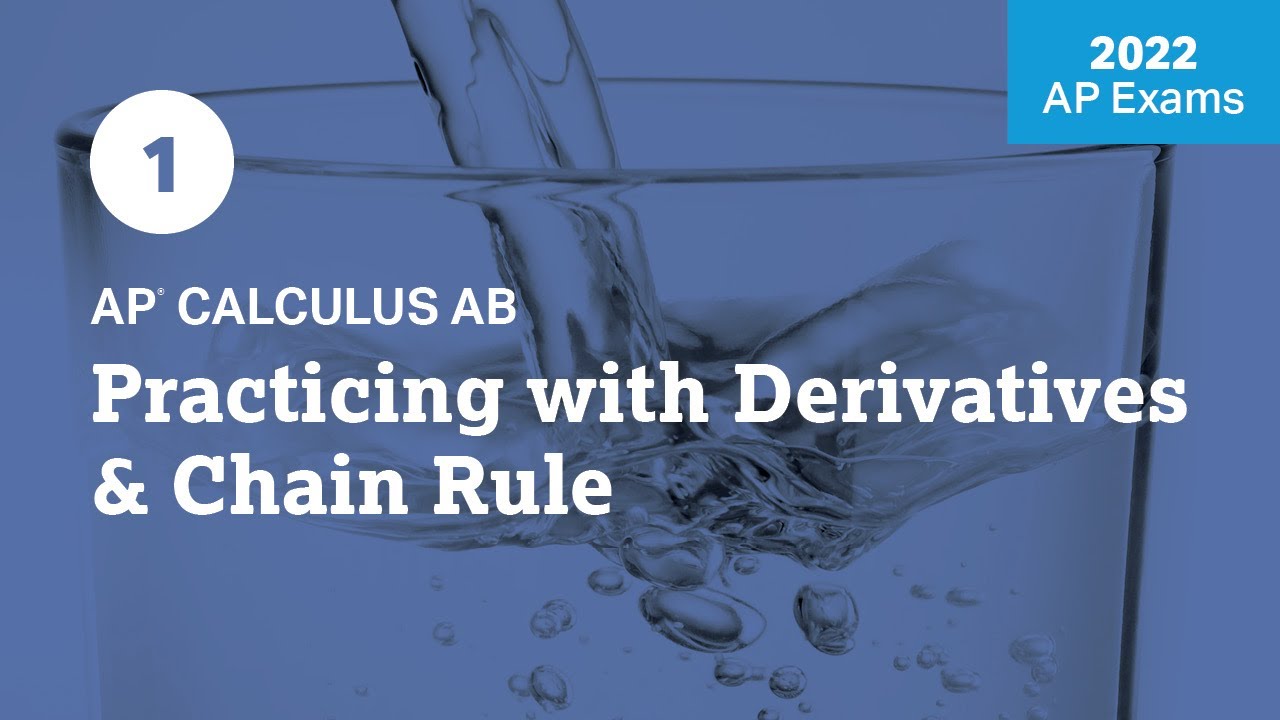AP Calculus Practice Exam Part 3 (MC #21-30)
TLDRIn this instructional video, the educator guides AP Calculus students through multiple-choice questions 21 to 30, focusing on derivative concepts, slope fields, and exponential functions. They tackle challenging problems involving natural exponential functions, critical points, and related rates, emphasizing the importance of understanding calculus rules and applying them effectively. The session also covers differential equations, vertical asymptotes, and Riemann sums, aiming to demystify complex topics and boost students' confidence in tackling the AP exam.
Takeaways
- 📚 The script is a lesson for AP Calculus students covering questions 21 through 30 without the use of a calculator.
- 🔍 Question 21 focuses on finding the derivative of a function, emphasizing the importance of understanding the sine function's derivative and applying the chain rule.
- 📉 In Question 22, the discussion involves slope fields and the use of decimals, highlighting the process of elimination to find the correct answer.
- 📈 For Question 23, the teacher sketches an exponential function and explains how to find the volume of a solid using cross-sections shaped as squares.
- 🧩 Question 24 involves evaluating an integral of a derivative, which simplifies to finding the original function, with the integral's limits of integration being key.
- 🔑 Question 25 explores finding the minimum value of a function using calculus, specifically focusing on critical points where the derivative equals zero.
- 💧 Question 26 relates to a real-world scenario involving the rate of water depth change, emphasizing the derivative as a measure of rate of change.
- 📊 Question 27 combines trigonometry with calculus to solve a related rates problem involving the angle of elevation of a balloon rising at a constant rate.
- 📐 The teacher simplifies a complex calculus problem in Question 28 by using trigonometric identities and the Pythagorean theorem to find the rate of change of an angle.
- 🕳 Question 29 discusses vertical asymptotes in the context of rational functions, illustrating how to identify holes in the function that create discontinuities.
- 📊 Question 30 delves into Riemann sums, explaining how to determine the change in x (Δx) by using the difference in the limits of integration over the number of intervals.
Q & A
What is the main concept being discussed in question 21 of the AP Cal exam?
-The main concept in question 21 is finding the derivative of a function, specifically the derivative of sine of 2x using the chain rule.
What is the significance of the 'X Plus H' term in the context of the derivative in question 21?
-The 'X Plus H' term is part of the function that the students are asked to differentiate. It's a common notation used when discussing limits and derivatives in calculus.
Why are slope fields mentioned in question 22 as a great question?
-Slope fields are considered a great question in the context because they test the understanding of differential equations and the ability to visualize and interpret the behavior of a function.
In question 22, how does the teacher determine the correct answer choice using the point (1,2)?
-The teacher uses the point (1,2) to estimate the slope of the tangent line at that point, comparing it with the options given and eliminating those that do not match the steepness observed.
What is the process described for finding the volume of a solid in question 23?
-The process involves integrating the area of the function y = e^x from 0 to 1, considering the cross-sections are squares, and using the formula for the area of a square (side^2), which in this case is e^(2x).
Why is the integral of a derivative equal to the original function in question 24?
-The integral of a derivative equals the original function because integration and differentiation are inverse processes. The integral 'undoes' what the derivative did, returning to the original function.
In question 26, how are critical points used to find the minimum value of a function?
-Critical points are found by setting the derivative of the function equal to zero and solving for x. These points are then evaluated in the original function to determine which one corresponds to the minimum value.
What does the derivative represent in the context of the water depth problem in question 27?
-In the context of the water depth problem, the derivative represents the rate of change of the water depth over time, indicating how quickly the depth is increasing or decreasing.
What is the approach to solving the related rates problem in question 28 involving a balloon?
-The approach involves writing an equation that relates the angle of elevation to the height of the balloon, taking the derivative with respect to time, and using known rates to solve for the unknown rate of change of the angle.
In question 29, how can you determine the vertical asymptotes of a rational function?
-Vertical asymptotes are determined by finding the values of x that make the denominator of the rational function equal to zero, as these values indicate points of discontinuity.
What is the purpose of the Riemann sum in question 30, and how is it related to the change in x (Δx)?
-The Riemann sum is used to approximate the integral of a function over an interval by summing the areas of rectangles. The change in x (Δx) is the width of each rectangle, which is found by dividing the difference in the limits of integration by the number of intervals.
Outlines
📚 Derivative Basics and AP Calc Strategies
This paragraph introduces the final 10 multiple-choice questions for AP Calculus students without a calculator. The focus is on understanding the questions' demands, particularly for finding derivatives, which is a fundamental concept. The instructor uses a conversational tone to guide students through the process, emphasizing the importance of recognizing the questions' underlying simplicity. The paragraph also touches on the transition from using limits to direct derivative rules in learning, aiming to boost students' confidence in tackling exam questions.
📈 Slope Fields and Exponential Functions
The second paragraph delves into a question involving slope fields and the absolute value function, guiding students through the process of elimination to find the correct answer. It then transitions to a discussion about exponential functions, specifically y = e^x, and the importance of understanding the graph and properties of this function. The instructor explains how to sketch the function and calculate the volume of a solid formed by revolving the graph around the x-axis, using integration and the area of square cross-sections.
📉 Calculus and Area Under a Curve
In this segment, the instructor discusses a problem involving the integral of a derivative, which simplifies to finding the original function. The focus is on understanding the limits of integration and how to evaluate the integral using the given graph. The explanation highlights the concept of anti-derivatives and the practical application of finding function values at specific points, emphasizing the importance of accurate calculation and interpretation of graphical data.
🔍 Critical Points and Function Minima
The fourth paragraph discusses the concept of critical points in calculus, which are essential for determining the minimum or maximum values of a function. The instructor provides a step-by-step guide on how to find the derivative, set it equal to zero, and solve for the variable to find critical points. The summary includes an example of finding the minimum value of a function within a specific interval, illustrating the process of plugging in values to determine the lowest y-value.
🚀 Rates of Change and Related Rates Problems
This paragraph explores the concept of rates of change, specifically focusing on the derivative as a measure of the rate at which a quantity is changing. The instructor uses the context of water depth increasing over time to explain how to approach related rates problems in calculus. The summary includes an explanation of how to interpret the given information, translate it into a calculus problem, and solve for the desired rate of change.
📐 Trigonometry Meets Calculus in Rate of Change
The instructor combines trigonometry and calculus to solve a problem involving the rate of change of an angle as a balloon rises. The explanation involves understanding the trigonometric relationship between the sides of a right triangle and applying the derivative to find the rate at which the angle is changing. The summary includes a detailed walkthrough of the algebraic manipulations and the application of the Pythagorean theorem to find the necessary lengths and angles.
🔍 Identifying Vertical Asymptotes in Rational Functions
In this segment, the focus is on identifying vertical asymptotes in rational functions, which occur where the denominator is zero. The instructor emphasizes the importance of simplifying the function before looking for asymptotes and explains the DOTS method to find factors that can cancel out. The summary clarifies the concept of holes in calculus and how they relate to discontinuities, specifically removable discontinuities.
📊 Understanding Riemann Sums and Calculus Concepts
The final paragraph discusses Riemann sums, a method used in calculus to approximate the definite integral of a function. The instructor explains the concept of Δx, the width of each rectangle in the Riemann sum, and how it relates to the change in x. The summary includes a problem-solving approach that involves setting up a proportion to find the correct value of n that makes Δx equal to the given expression, 2/n.
Mindmap
Keywords
💡Derivative
💡Chain Rule
💡Slope Field
💡Exponential Function
💡Integral
💡Anti-derivative
💡Critical Points
💡Differential Equations
💡Trigonometric Functions
💡Vertical Asymptote
💡Riemann Sum
Highlights
Introduction to AP Calculus questions 21-30, focusing on non-calculator multiple choice.
Explanation of the importance of recognizing when a problem is asking for a derivative.
Detailed walkthrough of finding the derivative of the function using the chain rule.
Introduction to slope fields and their importance in calculus problems.
Step-by-step process of solving a slope field problem using points and checking against possible values.
Discussion of exponential functions and their properties, using the example of y = e^x.
Explanation of finding the volume of a solid using integral calculus and cross-sections.
Illustration of how to integrate the area of a function to find volume, specifically using e^{2x}.
Review of the antiderivative of e^{2x} and the importance of correctly applying the chain rule.
Explanation of how to find the value of an integral given a graph and the concept of evaluating limits of integration.
Introduction to differential equations and the process of finding particular solutions by taking derivatives.
Discussion on critical points, how to find them by setting the derivative equal to zero, and evaluating them to find minimum values.
Explanation of the concept of a Riemann sum and its application in calculus to approximate the area under a curve.
Detailed explanation of related rates problems, including writing an equation relating variables and taking the derivative with respect to time.
Review of vertical asymptotes in rational functions, including factoring techniques and identifying holes and discontinuities.
Summary of solving a Riemann sum problem by identifying the delta X and setting up the correct proportion for limits of integration.
Transcripts
Browse More Related Video

2021 Live Review 5 | AP Calculus BC | Examining Differential Equations & Logistics

AP Calc AB & BC Practice MC Review Problems #6

Most Difficult AP Calculus FRQ Parts (Everyone in AB & BC Should Know)

Zoom session make up AP Calc Exam Review

2022 Live Review 2 | AP Calculus BC | Euler's Method, Logistics, and Differential Equations

2022 Live Review 1 | AP Calculus AB | Practicing with Derivatives & Chain Rule
5.0 / 5 (0 votes)
Thanks for rating: